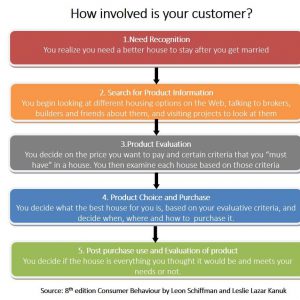Depicted below is a model of the stages in the consumer decision making process that consumers follow while buying either products or services. When buying either products or services, consumers are influenced by a variety of factors. Depending on a consumer’s experience and knowledge, some consumers may be able to make quick purchase decisions while other consumers may want to get more information and be more involved in the decision process before making a purchase. The level of involvement reflects how personally important the product or service to be purchased is to the consumer, how interested the consumer is in consuming a product and how much information he wants before making a purchase decision. While making such purchases, consumers display high or low involvement. It is important to know that such involvement encompasses not only the product or service to be purchased but the actual buying process per se as well.

Involvement around products
High-Involvement Products and their characteristics
High-involvement products are those that represents the consumer’s finances, personality, status and supporting lifestyle; for example, buying a house. These products represent a mix of rational as well asemotional motivators that contribute to a purchase.
1. High price: Where the price of the products are high consumers display high involvement. An example, could be buying a designer product or a car.
2. Major differences between alternatives: High involvement is caused when the consumer notices major differences between alternatives. For example, Android phones and a Windows phones. Consumers spend more time to evaluate the difference to arrive at the right decision.
3. Technical aspects: When a consumer buys products that have complex features then they spend more time in getting themselves familiarized with the product, which shows high involvement. In B2B such products are new software, new service concepts etc and in B2C sales such products include computers, refrigerators and so on.
4. Risk evaluation: Presence of high risks leads to high involvement. A consumer is interested to evaluate risks to know how to minimize them and if possible to avoid them; for example, hair colors and items for make-up contain chemicals. A consumer evaluates if its use can result in health problem, and if so, how to avoid such risks.
Low-Involvement Products and their characteristics
By contrast, low- involvement products are those that are more habitual or commoditized in nature and reflect routine purchases which are relatively low priced, simple and do not have a substantial effect on the buyer’s lifestyle, for example, buying a candy or bread or an ice cream.
1. Brand hopping: Some consumers do not display brand loyalty. They switch from one brand to another. Whenever a new consumer product appears in the market, they buy it on trial basis by being aprosumer. Brand hopping is common where differences between the brands are minimum.
2. Availability of alternative brands: When a consumer finds similar alternatives within the same product class, they choose to settle for any one brand. In this case, the buying process is not time consuming.
3. Effect on consumer’s self-image: This situation generally arises when the consumer is buying daily-consumption items; for example, if they want to buy brown bread, they may pick up the brown bread of Britannia or Modern. This is because it neither reflects the status nor damages the consumer’s image.
Involvement around purchase
High-Involvement Purchase and their characteristics
High-involvement purchases are those that represents the consumer’s psychological needs which are necessarily the emotional motivators that contribute to a purchase.
- Emotional risk: A high involvement purchase exists when a consumer has to buy a product or service that poses the risk of significant emotional consequences if a mistake is made. For e.g buying a party shirt.
- Projection of self: Some consumers are very specific about what they buy; for example, if a consumer claims that he uses only branded products, it means the consumer is ready to pay more for the brand and convince himself that he is not a run-of-the-mill type buyer. The same behaviour is seen while choosing jewellery, cosmetics, perfumes, cars, clothes, restaurants, and so on. As self-image is more dominating than the price of the product, the consumer intentionally pays more (in case the product commands a premium) because he is ruled by emotions and feelings.
Low-Involvement Purchase and their characteristics
Low-involvement purchases, on the contrary are those purchases that are driven by emotional motivators that do not gravely endanger the psychological needs of the buyer.
- Limited or No Emotional risk: The importance or the emotional significance of the purchase, correlate directly with the level of involvement. In this case it is low involving as the personal and social risks of making a bad purchase is low or limited
- No harm to Self-image: Causes no negative impressions in social or professional groups, or dent to his self-image.
Action by sales people
The buying experience of products and services in the B2B space as well as B2C space is dependent upon a range of the level of involvement that a consumer shows in the product or service as well as the purchase process per se without necessarily following a linearity.
Here’s an example
| Product/Service | Involvement in Product | Involvement in Purchase |
| New software | High | High |
| Party shirt | Low | High |
| Bread | low | low |
| A renewal contract | high | low |
TACK and InspireOne’s Consultative Selling philosophy states that sales people can play a significant role in the stage 3 and 4 in the model of the stages in the consumer decision making process (depicted above). A good quality of sales presentation is an important factor in influencing a buying decision. As the sales people are in direct contact with the Influencers, Gate-keepers and Decision makers in B2B sales or the direct consumers or prosumers in B2C sales, they are on a stronger footing to understand the rational needs and emotional needs of the consumer and thereby mold their presentations to make the sales person’s offering a high involvement product as well as a high involvement purchase for the consumer via usage of TACK tools such as F.I.N.D. and You Appeal. to ensure faster closures.








0 Comments